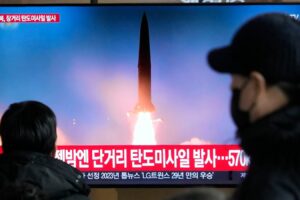State media calls launches a response to US-ROK air drills, while Kim Yo Jong says allies will ‘pay’ for their actions
North Korea fired two “tactical nuclear” rockets toward the East Sea (Sea of Japan) on Monday morning in response to U.S.-ROK aerial drills held the previous day, state media has announced.
A long-range artillery sub-unit in North Korea’s western area launched two 600mm rockets with target ranges of 395 km and 337 km in an artillery drill, according to a statement published by the official Korean Central News Agency (KCNA) on Monday.
The statement said the “tactical nuclear” rocket launchers can be used to “paralyze” enemy airfield operations.
“Today’s firing drill, using a tactical nuclear weapon, showed the Korean People’s Army’s thorough preparedness and willingness to respond to the U.S. and South Korea’s joint air forces, which are eager to gain air superiority,” KCNA warned.
Monday’s launches follow joint U.S.-ROK air drills on Sunday featuring B-1B strategic bombers in a demonstration of Washington’s commitment to “extended deterrence.” U.S. B-1B bombers also took part in separate aerial drills with fighter jets in Japan the same day.
Earlier this month, North Korea warned that if the U.S. continues to deploy strategic assets to the Korean Peninsula, it would respond with its own nuclear weapons.
The KCNA report came just hours after South Korea’s Joint Chiefs of Staff (JCS) announced on Monday that North Korea had launched two “ballistic missiles” eastward from Sukchon, South Phyongan Province. The ROK military subsequently reported that the missiles flew around 242 miles (390 km) and 211 miles (340 km) respectively.
Meanwhile, Japan’s defense ministry announced Monday morning that North Korea launched at least three ballistic missiles. The ministry estimated that two of the missiles had fallen as of 7:20 a.m. KST.
Later in the morning, Tokyo changed its assessment of the number of DPRK missiles from three to two. The defense ministry reported that the first missile traveled around 248 miles (400 km) and reached a maximum altitude of roughly 62 miles (100 km), while the second was estimated to have flown around 217 miles (350 km) with an apogee of 31 miles (50 km).
The reason for the initial discrepancy in Japan’s count is unclear, though there have occasionally been significant differences in Seoul and Tokyo’s assessments of past DPRK launches.
‘PAY THE PRICE’
Monday’s launches come two days after North Korea conducted a Hwasong-15 intercontinental ballistic missile (ICBM) drill on Saturday, which state media described as a warning to the U.S. and South Korea.
Kim Yo Jong, the North Korean leader’s sister, also warned on Monday that there is no change in North Korea’s determination to make the “first-class fanatics” in Seoul and Washington “pay the price” for their actions.
In a statement released through the official Korean Central News Agency (KCNA), she criticized outside researchers as “rookies” who were trying to “undervalue the preparedness of the DPRK missile forces.”
“Instead of doubting or worrying about other people’s skills, it would be better to think more deeply about countermeasures to defend yourself,” she said.
Kim Yo Jong appeared to defend the speed at which North Korea fired its Hwasong-15 on Saturday, calling it a “surprise launch,” and then went into a lengthy description of fuel ampulization and rocket science to describe the ICBM firing drill as a success.
Highlighting Pyongyang’s advances in missile development and production, as evident at a military parade on Feb. 8, she warned, “We have possessed satisfactory technology and capability and now will focus on increasing the quantity of their force.”
She also implied that the ROK and U.S. forces were spying on North Korea, saying that Saturday’s launch was planned for a window “when seven scout planes of the enemy involved in air reconnaissance landed.”
Lee Seong-joon, head of the JCS’ Public Affairs Office, refuted these allegations during a press briefing on Monday, telling reporters that “not all of North Korea’s claims are correct.”
The leader’s sister, who is also deputy director of Pyongyang’s propaganda and agitation department, also suggested the DPRK would continue firing missiles into the Pacific Ocean — and overflying Japan in the process.
“The frequency of using the Pacific as our firing range depends upon the U.S. forces’ action character,” Kim stated.
She previously issued another warning to the two allies on Sunday that they would face an “overwhelming response” for their “undisguised infringement” on the DPRK’s sovereignty.
On Friday, Pyongyang had threatened an “unprecedented” response to the allies upcoming military drills.
source: nknews
















